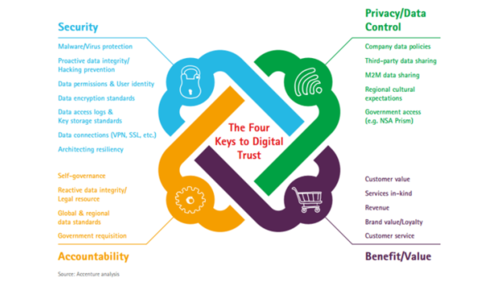Digital Trust
In the context of information technology and the business use of consumer data, digital trust is the confidence placed in an organization to collect, store and use the digital information of others in a manner that benefits and protects those to whom the information pertains. Digital trust is the currency of today and will be central to defining the high performers of tomorrow.[1]
Accenture has defined four keys to digital trust from a consumer perspective. Each dimension must be satisfied to establish consumer trust in a specific brand:
Security—Protecting information against theft or unauthorized use.
Privacy/Data control— Controlling who gains legal access to personal information, when they get access, and what they can do with it.
Benefit/Value— Offering reciprocal benefits that are directly relevant to the data businesses are collecting and storing. This means that the data being collected is clearly necessary to providing the service.
Accountability—Taking responsibility for misuse and incorrect information and ensuring corrective action.[2]

source:Accenture
The determinants of an individual's degree of trust are a function of one’s perception of risk, which stems from various contextual factors (the social environment through norms, values, and conventions), the quality and quantity of information available, and one’s natural disposition to trust. In general, while context and disposition to trust are stable over time, the quantity and quality of information, which establish whether the individual believes that s/he is in a risky or uncertain situation, vary over time. Trust is therefore a dynamic process marked by various phases of trust development. The Online Trust Building Model (figure below) proposed by Head and Hassanein, identifies four phases in this process

source:ILNAS
This model shows consumer behavior at each phase, as well as the consumer's interactions with two other transaction partners: the vendor, obviously, and a third party. This third party provides sources of external information to the consumer: it could be a friend, a consumer website, an advertisement, or even a public certification. Therefore each phase is marked by a distinct mechanism for building and structuring consumer trust. At each phase, the consumer must decide whether or not to engage in a transaction, and at each phase, he must evaluate whether or not to continue this relationship. In sum, he accumulates experience and information that will gradually reduce his ignorance as he moves from the initial phase to the final phase.
The four phases are as follows:
The chaos phase: this is the initial phase of the model where the consumer is in a situation of radical uncertainty.
The trust establishment phase: Having issued the desire to consume a product or service, the consumer will seek to reduce his ignorance. He will seek signals showing that the vendor merits his trust. This is the phase in which the consumer compares vendors and/or products and, in particular, will seek the advice of third parties.
The enhancement phase: The consumer has successfully completed his first transaction. He is therefore able to evaluate the consequences of this decision with a bit more precision. This first experience is determinant, and conditions the continuity of the relationship with the vendor. Starting with this phase, the consumer is able to judge the quality of the advice from the third party, and he is no longer in a situation of radical uncertainty.
The maintenance phase: At this point, the consumer has conducted several successful transactions. His ignorance has been significantly reduced, and he has broad experience on the subject: previous interactions with the vendor drive this trust. Because of this, the third party no longer has any real impact on the consumer's decision-making process, and there are strong chances that he will engage in a long-term relationship with the vendor.[3]
References
Further Reading
- Digital trust in the internet of things era Accenture
- Building Digital Trust - The confidence to take risks Price Waterhouse
- Ten digital trust challenges PWC
- Digital Trust and Cyber Security PA Consulting
- Research Paper: “The Digital Trust Paradox” Business Value Exchange
